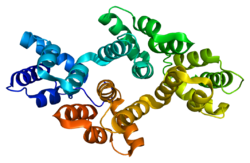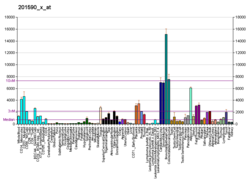Annexin A2
Annexin A2 also known as annexin II is a protein that in humans is encoded by the ANXA2 gene.[5]
Annexin 2 is involved in diverse cellular processes such as cell motility (especially that of the epithelial cells), linkage of membrane-associated protein complexes to the actin cytoskeleton, endocytosis, fibrinolysis, ion channel formation, and cell matrix interactions. It is a calcium-dependent phospholipid-binding protein whose function is to help organize exocytosis of intracellular proteins to the extracellular domain. Annexin II is a pleiotropic protein meaning that its function is dependent on place and time in the body.
Gene
The ANXA2 gene, located at 15q22.2, has three pseudogenes located on chromosomes 4, 9 and 10, respectively. Multiple alternatively spliced transcript variants encoding different isoforms have been found for this gene.[6]
Function
This protein is a member of the annexin family. Members of this calcium-dependent phospholipid-binding protein family play a role in the regulation of cellular growth and in signal transduction pathways. This protein functions as an autocrine factor which heightens osteoclast formation and bone resorption.[6] Epigenetic regulation of Annexin A2 has been identified as a key determinant of mesenchymal transformation in brain tumors.[7]
Annexin A2 has been proposed to function inside the cell in sorting of endosomes and outside the cell in anticoagulant reactions.
Interactions
Annexin A2 has been shown to interact with Prohibitin,[8] CEACAM1,[9] S100A10,[10][11] PCNA,[12] complement Factor H,[13] and a number of viral factors including the HPV16 minor capsid protein L2.[14][15]
See also
References
- ^ a b c GRCh38: Ensembl release 89: ENSG00000182718 – Ensembl, May 2017
- ^ a b c GRCm38: Ensembl release 89: ENSMUSG00000032231 – Ensembl, May 2017
- ^ "Human PubMed Reference:". National Center for Biotechnology Information, U.S. National Library of Medicine.
- ^ "Mouse PubMed Reference:". National Center for Biotechnology Information, U.S. National Library of Medicine.
- ^ Takahashi S, Reddy SV, Chirgwin JM, Devlin R, Haipek C, Anderson J, Roodman GD (Nov 1994). "Cloning and identification of annexin II as an autocrine/paracrine factor that increases osteoclast formation and bone resorption". The Journal of Biological Chemistry. 269 (46): 28696–701. PMID 7961821.
- ^ a b "Entrez Gene: ANXA2 annexin A2".
- ^ Kling T, Ferrarese R, Ó hAilín D, Johansson P, Heiland DH, Dai F, Vasilikos I, Weyerbrock A, Jörnsten R, Carro MS, Nelander S (Sep 2016). "Integrative Modeling Reveals Annexin A2-mediated Epigenetic Control of Mesenchymal Glioblastoma". EBioMedicine.
- ^ Bacher S, Achatz G, Schmitz ML, Lamers MC (Dec 2002). "Prohibitin and prohibitone are contained in high-molecular weight complexes and interact with alpha-actinin and annexin A2". Biochimie. 84 (12): 1207–20. doi:10.1016/S0300-9084(02)00027-5. PMID 12628297.
- ^ Kirshner J, Schumann D, Shively JE (Dec 2003). "CEACAM1, a cell-cell adhesion molecule, directly associates with annexin II in a three-dimensional model of mammary morphogenesis". The Journal of Biological Chemistry. 278 (50): 50338–45. doi:10.1074/jbc.M309115200. PMID 14522961.
- ^ Réty S, Sopkova J, Renouard M, Osterloh D, Gerke V, Tabaries S, Russo-Marie F, Lewit-Bentley A (Jan 1999). "The crystal structure of a complex of p11 with the annexin II N-terminal peptide". Nature Structural Biology. 6 (1): 89–95. doi:10.1038/4965. PMID 9886297.
- ^ He KL, Deora AB, Xiong H, Ling Q, Weksler BB, Niesvizky R, Hajjar KA (Jul 2008). "Endothelial cell annexin A2 regulates polyubiquitination and degradation of its binding partner S100A10/p11". The Journal of Biological Chemistry. 283 (28): 19192–200. doi:10.1074/jbc.M800100200. PMC 2443646. PMID 18434302.
{{cite journal}}: CS1 maint: unflagged free DOI (link) - ^ Ohta S, Shiomi Y, Sugimoto K, Obuse C, Tsurimoto T (Oct 2002). "A proteomics approach to identify proliferating cell nuclear antigen (PCNA)-binding proteins in human cell lysates. Identification of the human CHL12/RFCs2-5 complex as a novel PCNA-binding protein". The Journal of Biological Chemistry. 277 (43): 40362–7. doi:10.1074/jbc.M206194200. PMID 12171929.
- ^ Leffler J, Herbert AP, Norström E, Schmidt CQ, Barlow PN, Blom AM, Martin M (Feb 2010). "Annexin-II, DNA, and histones serve as factor H ligands on the surface of apoptotic cells". The Journal of Biological Chemistry. 285 (6): 3766–76. doi:10.1074/jbc.M109.045427. PMC 2823518. PMID 19951950.
{{cite journal}}: CS1 maint: unflagged free DOI (link) - ^ Woodham AW, Da Silva DM, Skeate JG, Raff AB, Ambroso MR, Brand HE, Isas JM, Langen R, Kast WM (2012). "The S100A10 subunit of the annexin A2 heterotetramer facilitates L2-mediated human papillomavirus infection". PLoS One. 7 (8): e43519. doi:10.1371/journal.pone.0043519. PMC 3425544. PMID 22927980.
{{cite journal}}: CS1 maint: unflagged free DOI (link) - ^ Woodham AW, Raff AB, Raff LM, Da Silva DM, Yan L, Skeate JG, Wong MK, Lin YG, Kast WM (May 2014). "Inhibition of Langerhans cell maturation by human papillomavirus type 16: a novel role for the annexin A2 heterotetramer in immune suppression". Journal of Immunology. 192 (10): 4748–57. doi:10.4049/jimmunol.1303190. PMC 4019435. PMID 24719459.
Further reading
- Kwon M, MacLeod TJ, Zhang Y, Waisman DM (Jan 2005). "S100A10, annexin A2, and annexin a2 heterotetramer as candidate plasminogen receptors". Frontiers in Bioscience. 10 (1–3): 300–25. doi:10.2741/1529. PMID 15574370.
- Babiychuk EB, Draeger A (Jun 2006). "Regulation of ecto-5'-nucleotidase activity via Ca2+-dependent, annexin 2-mediated membrane rearrangement?". Biochemical Society Transactions. 34 (Pt 3): 374–6. doi:10.1042/BST0340374. PMID 16709165.
- Bohn E, Gerke V, Kresse H, Löffler BM, Kunze H (Jan 1992). "Annexin II inhibits calcium-dependent phospholipase A1 and lysophospholipase but not triacyl glycerol lipase activities of rat liver hepatic lipase". FEBS Letters. 296 (3): 237–40. doi:10.1016/0014-5793(92)80294-Q. PMID 1531641.
- Dawson SJ, White LA (May 1992). "Treatment of Haemophilus aphrophilus endocarditis with ciprofloxacin". The Journal of Infection. 24 (3): 317–20. doi:10.1016/S0163-4453(05)80037-4. PMID 1602151.
- Jindal HK, Chaney WG, Anderson CW, Davis RG, Vishwanatha JK (Mar 1991). "The protein-tyrosine kinase substrate, calpactin I heavy chain (p36), is part of the primer recognition protein complex that interacts with DNA polymerase alpha". The Journal of Biological Chemistry. 266 (8): 5169–76. PMID 1825830.
- Filipek A, Gerke V, Weber K, Kuźnicki J (Feb 1991). "Characterization of the cell-cycle-regulated protein calcyclin from Ehrlich ascites tumor cells. Identification of two binding proteins obtained by Ca2(+)-dependent affinity chromatography". European Journal of Biochemistry / FEBS. 195 (3): 795–800. doi:10.1111/j.1432-1033.1991.tb15768.x. PMID 1999197.
- Becker T, Weber K, Johnsson N (Dec 1990). "Protein-protein recognition via short amphiphilic helices; a mutational analysis of the binding site of annexin II for p11". The EMBO Journal. 9 (13): 4207–13. doi:10.1002/j.1460-2075.1990.tb07868.x. PMC 552202. PMID 2148288.
- Spano F, Raugei G, Palla E, Colella C, Melli M (Nov 1990). "Characterization of the human lipocortin-2-encoding multigene family: its structure suggests the existence of a short amino acid unit undergoing duplication". Gene. 95 (2): 243–51. doi:10.1016/0378-1119(90)90367-Z. PMID 2174397.
- Johnsson N, Johnsson K, Weber K (Aug 1988). "A discontinuous epitope on p36, the major substrate of src tyrosine-protein-kinase, brings the phosphorylation site into the neighbourhood of a consensus sequence for Ca2+/lipid-binding proteins". FEBS Letters. 236 (1): 201–4. doi:10.1016/0014-5793(88)80314-4. PMID 2456953.
- Gould KL, Woodgett JR, Isacke CM, Hunter T (Jul 1986). "The protein-tyrosine kinase substrate p36 is also a substrate for protein kinase C in vitro and in vivo". Molecular and Cellular Biology. 6 (7): 2738–44. doi:10.1128/mcb.6.7.2738. PMC 367834. PMID 2946940.
- Huebner K, Cannizzaro LA, Frey AZ, Hecht BK, Hecht F, Croce CM, Wallner BP (May 1988). "Chromosomal localization of the human genes for lipocortin I and lipocortin II". Oncogene Research. 2 (4): 299–310. PMID 2969496.
- Huang KS, Wallner BP, Mattaliano RJ, Tizard R, Burne C, Frey A, Hession C, McGray P, Sinclair LK, Chow EP (Jul 1986). "Two human 35 kd inhibitors of phospholipase A2 are related to substrates of pp60v-src and of the epidermal growth factor receptor/kinase". Cell. 46 (2): 191–9. doi:10.1016/0092-8674(86)90736-1. PMID 3013422.
- Buday L, Egan SE, Rodriguez Viciana P, Cantrell DA, Downward J (Mar 1994). "A complex of Grb2 adaptor protein, Sos exchange factor, and a 36-kDa membrane-bound tyrosine phosphoprotein is implicated in ras activation in T cells". The Journal of Biological Chemistry. 269 (12): 9019–23. PMID 7510700.
- Chung CY, Erickson HP (Jul 1994). "Cell surface annexin II is a high affinity receptor for the alternatively spliced segment of tenascin-C". The Journal of Cell Biology. 126 (2): 539–48. doi:10.1083/jcb.126.2.539. PMC 2200039. PMID 7518469.
- Kato S, Sekine S, Oh SW, Kim NS, Umezawa Y, Abe N, Yokoyama-Kobayashi M, Aoki T (Dec 1994). "Construction of a human full-length cDNA bank". Gene. 150 (2): 243–50. doi:10.1016/0378-1119(94)90433-2. PMID 7821789.
- Richard I, Broux O, Chiannilkulchai N, Fougerousse F, Allamand V, Bourg N, Brenguier L, Devaud C, Pasturaud P, Roudaut C (Oct 1994). "Regional localization of human chromosome 15 loci". Genomics. 23 (3): 619–27. doi:10.1006/geno.1994.1550. PMID 7851890.
- Takahashi S, Reddy SV, Chirgwin JM, Devlin R, Haipek C, Anderson J, Roodman GD (Nov 1994). "Cloning and identification of annexin II as an autocrine/paracrine factor that increases osteoclast formation and bone resorption". The Journal of Biological Chemistry. 269 (46): 28696–701. PMID 7961821.
- Hyatt SL, Liao L, Chapline C, Jaken S (Feb 1994). "Identification and characterization of alpha-protein kinase C binding proteins in normal and transformed REF52 cells". Biochemistry. 33 (5): 1223–8. doi:10.1021/bi00171a023. PMID 8110754.
- Wright JF, Kurosky A, Wasi S (Feb 1994). "An endothelial cell-surface form of annexin II binds human cytomegalovirus". Biochemical and Biophysical Research Communications. 198 (3): 983–9. doi:10.1006/bbrc.1994.1140. PMID 8117306.
- Maruyama K, Sugano S (Jan 1994). "Oligo-capping: a simple method to replace the cap structure of eukaryotic mRNAs with oligoribonucleotides". Gene. 138 (1–2): 171–4. doi:10.1016/0378-1119(94)90802-8. PMID 8125298.
External links
- Annexin+A2 at the U.S. National Library of Medicine Medical Subject Headings (MeSH)
- Human ANXA2 genome location and ANXA2 gene details page in the UCSC Genome Browser.













